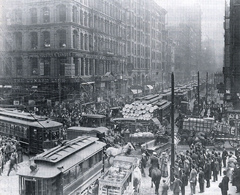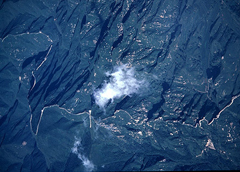| barriers | |||
| HOME | ABSTRACT | UNDERPINNINGS SITE | PROGRAM | PROCESS | DESIGN |
UP.DANIEL LUSTER | ||
|
|
[keywords] limit, delineate, protect, mark, define, permeablity, control, power [background] On some level, every effort of humanity, every exhaustion of industry, is of the same ends; to create, sustain, and/or destroy barriers. It is the essential notion of home, of the city, of the person. Metaphysically barriers define us, they are an underline to our distinctions, give faces to our oppositions. Yet they are perhaps the most common things we have, generating a realm in which we can act in concert. The togetherness of opposition has characterized our history. One thinks of Greece, the epitome of the fractured people yet in the face of opposition they seemingly acted as one to draw the lines of distinction, to defend, to enact a barrier. The first and perhaps most iconic type of barrier is the one which is design to keep out. The city wall, the castle, the Great Wall of China, all fundamentally provide for fortification and repulsion of some ‘other’ group of people. It is this fundamental notion of barrier to which we are most drawn in our mental conception. To define the extents, the limits to which one can safely venture and then make tangible and tactile markers to warn the insider and repel the outsider. This understanding of barriers is linked and ultimately limited to a war fare that is trapped in one dimension, where attacks are staged at speeds and trajectories parallel and in concert with the ground plane and consequently with the topography, geography and particular nature of the place where the war is being waged. This limited scope of combat was the defining element in the construction of barriers in war. Paul Virilio points out in his book Bunker Archeology[1] that as warfare developed and shifted its interest from the ground plane to the sky – this was caused by the implementation of the airplane and its subsequent arming as a weapon – thus activating the volume of space. With this one can observe the advent of what he calls the idea of total war, a war with out lines and boundaries where one is simultaneously exposed to death and destruction from all sides, from space. It is this jump from the ground to the sky and then eventually to the ultimate reaches of outer space that has transformed our notions of barriers, they no longer can function in the same manner, adaptation to new technology, speeds, and operations became the paramount concern when making barriers. The barrier is now only a theoretical delineation, a discontinuous line of demarcation, an abstraction. It is no longer possible to define in and out as concretely, as planes and satellites circumvent the supposed borders almost without concern and certainly at will thus undoing our previous notions of barriers. According to Virilio this is then compounded by the threat of nuclear war and its associated dogma of total destruction, mankind has now mastered the atom and split it, thus undoing the final barrier: matter and non-matter. In a world of two-dimensional operations flight, moving towards the infinite horizon, is the natural and effective means of protection, but now there is only one option to dig. To move from the surface to the ground and under it, to retract and move down out of ‘sight’, not the sight of the man but of the machine, of the bomb. Modernism not only changed the nature of the barrier in terms of its role in the delineation and defense of places but also brought about a fundamental change in function of the barrier. Evelyn Preuss discusses the notion that the modern wall, as seen in the soviet unions iron curtain, can play a different role than to keep out: to keep in. She writes,
There is another realm in which the development of barriers has undergone many degrees of change and has maintained perhaps the most prevailing determinant in the history of human exploits. It is the line of most consequence, the simultaneously starkly defined yet strikingly ambiguous distinction between public and private. In her book Privacy and Publicity Beatriz Colomina discusses the transition to the modern period and its effect upon the physiological state of the private individual [3]. The city is no longer a place of refuge, due to industrialization, and is thus now a thing to be escaped, to be avoided. In response the individual most create a distinction between himself and the rest of the world, a clear line of public and private. This barrier is equally as interested in control, yet a control not of landscape or terrain or even three-dimensional space but rather of the self and the right to be distinctive. It is this flight to the inward world of self, which has impacted our cities and our cultures more than perhaps anything else; to create the inward world with all its barriers and walls is the new project of the modern human condition.
[references] 1. Paul Virilio, Bunker Archeology(New York: Princeton Architectural Press, 1965): 2. Evelyn Preuss, "The Wall You Will Never Know," Perspecta, v. 36, (2005):19-30. 3. Beatriz Colomina, Privacy and publicity : modern architecture as mass media (Cambridge, Mass. : MIT Press, 1994):
barriers | landscapes of war | postcard | tourisms | reasonable war | american myth |
|
|
|||
 |
|||
| 02 | |||
| 03 | |||
 |
|||
| 04 | |||
01. Aerial view of the Great Wall of China, photo Dennis Cox, www.denniscox.com/greatwall.htm 02.City wall of Vincenza, Italy 03. the Berlin Wall, 1973 04. the industrial city photo www.americansolvent.com |
|||
| © university of tennessee college of architecture and design | |||
